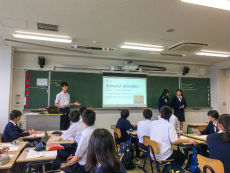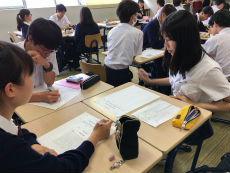
学園ブログ

- ホーム
- 世界へはばたく
世界へはばたく

2018年06月26日
高校2年生のEIPコースでの取り組み

1学期間を通して、高校2年生の生徒たちは、EIP(※)コース最初の課題として、グループでのプレゼンテーションに取り組んできました。3~4人が1つのグループとなり、関西を訪れる外国人観光客に3日間のプランを作ってあげるというのが課題です。
最初の授業で、家族の友だちが何人か日本にやってくるという架空の状況を例として提示しました。関西に3日間滞在するとして、彼らのために旅程の詳細を作ろうということを伝えました。
2回目の授業では、生徒たちに関西について調べたり、できるだけたくさんのアイディアを出したりさせました。それぞれのグループに1台ずつiPadも配り、大阪城やUSJなど、観光客がみんな行きたがる有名な場所だけでなく、地元の人にしか知られていないような場所も織り交ぜるように促しました。
次の授業では、アイディアをまとまりのあるプランへと移し、プレゼンテーションの台本を書き始めました。
この後は、ひたすら練習です。ただ、話すだけでなく、アイコンタクトやジェスチャー、顔の表情などにも気をつけるように話しました。これらの非言語的な表現方法は、評価対象の1つでもあります。他にも、プレゼンテーションでの英語、まとまり、視覚情報とプレゼンテーション後の質問に答える能力が評価の対象でした。生徒には、あらかじめ、評価基準の詳細(ルーブリック)が書いた紙が配られていますので、プレゼンテーションをする間、何に気をつけるべきなのかを知ることができます。


その次の授業から、実際にプレゼンテーションを始めました。全員にワークシートが配られ、それぞれのグループのプランについてメモを取りながら聞きました。それぞれのプレゼンテーションの最後には、聞いている人が質問をしました。たくさんの人が原稿を暗記していたので、教室中を見渡したり、ジェスチャーを使ったりする余裕が見られ、その姿に、私たちは感激しました。また、ほとんどの生徒が面白い写真や画像を用い、プレゼンテーションをよくしようと努めていました。
(※) EIP:English Interaction and Production
Throughout the first semester, high school second years have been working towards delivering group presentations as their first EIP assessment of the school year. Their task was, in groups of 3 or 4, to create a 3-day plan for visitors to Kansai.
In the first lesson we described the fictional situation of the assessment; the students have some family friends coming to visit Japan. They will spend three days in Kansai, and the students must create a detailed itinerary for them.
The second lesson was to let the students research Kansai and come up with as many ideas as possible. We provided iPads for each group, and encouraged students to think of a mixture of famous tourist attractions like Osaka Castle and USJ, but to also include some ideas that perhaps only locals would know about. During the next lesson, they refined their ideas into a cohesive plan, and began working on their presentation scripts.
After this, it was time to practice, practice, practice! We encouraged students to consider their non-verbal delivery, which includes eye contact, gestures, and facial expression. Non-verbal delivery was one of the categories the teachers were scoring, along with verbal-delivery, organization, visual aids and question answering ability. The students were all given a copy of the scoring rubric, so they would know what to focus on while presenting.
The next lesson, we began the presentations. The students were all given a worksheet so they could take notes on each group’s plan. At the end of each presentation, the audience was encouraged to ask questions about the plans. The teachers were impressed by how many students memorized their scripts, and therefore were free to look around the room and use gestures, instead of having to rely on reading from the paper. Most students also made interesting visual aids to enhance their presentations.
The students seemed to enjoy working together to create their ideal Kansai itinerary, and embraced the freedom to choose and speak about their own favourite sights and attractions. This exercise was a good precursor to next semester, where the students who perform well in the next speaking test, will have the opportunity to enter a speech contest.
(中高校ALT キャサリン・ハーン)
